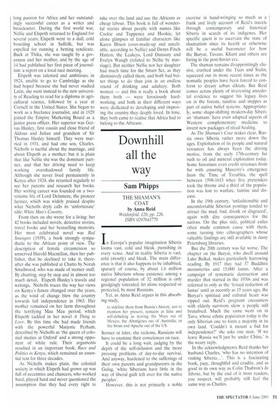Downhill all the way
Sam Phipps
THE SHAMAN'S COAT by Anna Reid Weidenfeld, £20, pp. 226, ISBN 0297643770 In Europe's popular imagination Siberia looms vast, cold and bleak, punishing in every sense. And in reality Siberia is vast, cold (mostly) and bleak. The main difference is that it also happens to be inhabited, sparsely of course, by about 1.6 million native Siberians whose existence among a regional population of 32 million is only grudgingly tolerated, let alone respected or protected, by most Russians.
Yet, as Anna Reid argues in this absorbing study,
to sideline them from Russia's history, not to mention her present, remains as false and self-deluding as leaving the Maya out of Mexico, the Aborigines out of Australia, or the Sioux and Apache out of the US.
Sooner or later, she reckons, Russians will have to examine their consciences on race.
It could be a long wait, judging by the depth of the self-delusion and the more pressing problems of day-to-day survival. And anyway, hardened to the sufferings of their own parents and grandparents in the Gulag, 'white Siberians have little in the way of liberal guilt left over for the native peoples'.
However, this is not primarily a noble exercise in hand-wringing so much as a frank and lively account of Reid's travels through contemporary and historical Siberia in search of its indigenes. Her specific quest is to ascertain the state of shamanism since its health or otherwise will be a useful barometer for how the Buryat, Tuvans, Khant and others are faring in the post-Soviet era.
The shaman remains disappointingly elusive, crushed under the Tsars and Stalin, squeezed out in more recent times as the nomadic peoples have been forced to conform to dreary urban diktats. But Reid comes across plenty of interesting anecdotal evidence to suggest his legacy lives on in the forests, tundras and steppes as part of native belief systems. Appropriately, some shape-shifting modern-day Siberian 'shamans' have even adapted aspects of Western complementary medicine to invent new packages of ritual healing.
As The Shaman's Coat makes clear, Russia owes Siberia rather more down the ages. Exploitation of its people and natural resources has always been the driving motive, from the early 17th-century fur rush to oil and mineral exploration today. Some historians even credit revenues from fur with ensuring Muscovy's emergence from the Time of Troubles, the spell between 1598-1613 when five pretenders took the throne and a third of the population was lost to warfare, famine and disease.
In the 19th century, 'unfashionable and uncomfortable Siberian postings tended to attract the mad, bad, drunk or disgraced', again with dire consequences for the natives. On the plus side, political exiles often made common cause with them, some turning into ethnographers whose valuable findings are still available in dusty Petersburg libraries.
But the 20th centurywas far worse. The chapter on the Buryat, who dwell around Lake Baikal. makes particularly harrowing reading. By 1917 they had 37 Buddhist monasteries and 15,000 lamas. After a campaign of systematic destruction and murder that started in the 1930s and was referred to only as the 'forced reduction of lamas' until as recently as 15 years ago, the Buryat's spiritual and cultural heart was ripped out. Reid's poignant encounters with elderly survivors show a people still brutalised. Much the same went on in Tuva, whose ethnic population today is the only Siberian one to form a majority in its own land. 'Couldn't it mount a bid for independence?' she asks one man. 'If we leave Russia we'll just be under China,' is the weary reply.
In the acknowledgments Reid thanks her husband Charles, 'who has no intention of visiting Siberia...'. This is a fascinating book, pacy, thoughtful and erudite, and as good in its own way as Colin Thubron's In Siberia, but by the end of it most readers, you suspect, will probably still feel the same way as Charles.






















































































 Previous page
Previous page